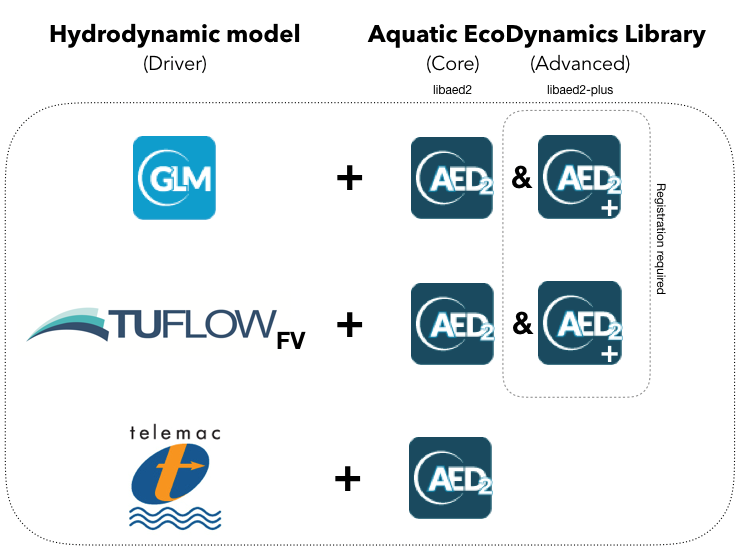Coupling Approach & Related Software
The AED/AED2/AED2+ software is a "library" of modules that contain a diverse set of algorithms for simulating aquatic ecosystems. To run they must be connected with a "host" model (aka driver model) that is able to simulate the transport (advection and mixing) of the water quality attributes. Additionally, the host model also simulates environmental conditions (e.g., light, salinity and temperature) that are required by water quality algorithms.
Currently there are three main host models that are routinely used with the AED2 modules for coupled hydrodynamic-biogeochemical simulations. These include, GLM, TUFLOW-FV, and TELEMAC3D, and are described below.
GLM: The General Lake Model
The GLM is also developed at UWA and is a water balance and one-dimensional vertical stratification hydrodynamic model that is designed to couple with AED2 for simulation of water quality attributes and aquatic ecology.
TUFLOW-FV: 3D flexible-mesh hydrodynamic model
TUFLOW-FV is a 3D flexible-mesh (finite volume) hydrodynamic model (developed by BMTWBM) that can be used for modelling a diverse array of inland and coastal water bodies and it is able to call the AED library directly via a custom interface. The model accounts for variations in water level, the horizontal salinity distribution and vertical density stratification in response to inflows, salt-wedge dynamics and surface thermodynamics. The finite volume numerical scheme solves the conservative integral form of the non linear shallow water equations in addition to the advection and transport of scalar constituents such as salinity and temperature and the state variables from the coupled biogeochemical model. The equations are solved in 3D with baroclinic coupling with both salinity and temperature using the UNESCO equation of state. Both 1st and 2nd order spatial integration schemes are available, and the temporal integration scheme is explicit and uses both mode-splitting and dynamically varying timesteps to maximize computational efficiency subject to Courant and Peclet stability constraints. Surface momentum exchange and heat dynamics are solved internally within the model from available meteorological boundary condition data. In the current application, turbulent mixing of momentum and scalars has been calculated using the Smagorinsky scheme in a horizontal plane and through various options for vertical mixing.
TELEMAC: An open-source 3D flexible mesh hydrodynamic model
Telemac is a software framework for simulating hydrodynamics. It includes a range of modules for simulating water bodies, including sediment transport and wave dynamics.
FABM: The Framework for Aquatic Biogeochemical Models
FABM is a software framework for simulating biogeochemical models. It allows multiple bio-geochemical models to be configured and interact with each other, and for those models to connect with a diverse array of hydrodynamic drivers (e.g. GLM).

